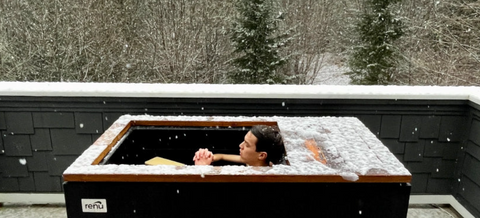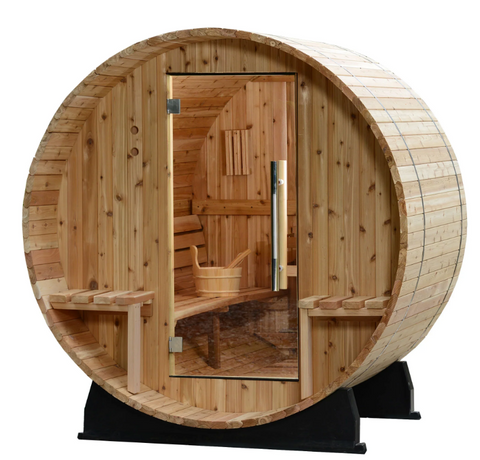What Is Cold Water Immersion Therapy?
Cold water immersion therapy, sometimes called cold plunge therapy, is a version of cryotherapy where athletes submerge themselves in chilly water up to the chest for around ten minutes. Mike Reinold, D.P.T., C.S.C.S., a physical therapist and former head athletic trainer for the Boston Red Sox, says “Ice baths help people move and feel better, which can help them to recover.” And he’s not alone. Cold water immersion (CWI) therapy has been used for decades now to help athletes recover after sports injuries or extremely taxing training days. So how does CWI work on sports injury and muscle soreness?
The Principles Behind Cold Immersion After Exercise
Ice baths can help reduce inflammation and improve recovery by influencing how blood and other fluids flow throughout the body. Sitting in cold water causes blood vessels to constrict, and then they dilate (open up) when you get out of the cold water. This process can help flush the circulatory system of metabolic wastes produced by the body after a workout and increase vascular elasticity. And, these principles hold true with the lymphatic system, which produces fluids made up of white blood cells and fluid from your intestines and helps clean the body of toxins.
Johanna Lanner, an expert in muscle physiology from the Karolinska Institute in Sweden, explains the principles behind cold water immersion therapy after exercise:
“Cooling i) reduces nerve impulse transmission and thus reduces the level of pain perception and ii) induces constriction of blood vessels in peripheral tissues (e.g., muscle) which results in reduced fluid diffusion that may assist in reducing exercise-induced acute inflammation.”
And that ice baths are effective at:
“reducing the symptoms of exercise-induced delayed onset muscle soreness i.e., pain and stiffness experienced in muscles several hours to days (usually 24-72 hours) after unaccustomed or strenuous exercise.”
Scientific Research Reveals Sports Training Benefits Of CWI
Ice Baths May Help Reduce Delayed Onset Muscle Soreness
Some research suggests ice baths may reduce soreness after workouts. A 2018 meta analysis of 99 studies looked at the effectiveness of several methods of muscle soreness recovery methods. These methods included cold water immersion therapy, contrast therapy, and massage. Each method was measured for how well they reduced delayed onset muscle soreness, perceived fatigue, muscle damage, and inflammation after physical exercise.
The study results indicated ice baths and massages had the most positive impact at lowering inflammation after working out. Massages were found to be the best for reducing muscle soreness and fatigue, but getting a massage after every workout can add serious costs for recovery.
CWI and Heart Rate Variability
Another expert also claims improved heart rate variability (HRV) stems from cold water immersion therapy. HRV is a leading indicator of heart performance, and the more HRV the better. Llion Roberts, an expert in exercise physiology from Griffith University in Australia, says:
“Cold water immersion is also known to help restore heart rate variability, the variation in the millisecond time periods between successive heartbeats.”
Improvements in HRV can benefit athletes in a variety of ways. It’s been found that HRV-guided training may induce greater performance gains than pre-planned training programs that don’t account for HRV. It’s also been found that HRV may be a useful predictor for illnesses such as upper respiratory tract and pulmonary infections. Injury recovery comes down to staying healthy, and this is just another way CWI might help with this.
How to Do Cold Water Therapy?
How Long Should Athletes Sit in Ice Baths?
A 2016 meta-analysis of ice bath studies revealed that on average, athletes experienced the most positive outcomes from soaking in water temperatures ranging from 50 to 59 °F for 10 to 15 minutes.
To achieve the same results at home, it’s important to ensure your tub’s water temperature is within the optimal range for your body. Safe cold water therapy comes down to having total control over water temperature. Trying to regulate water temperature with bags of ice in a regular tub can be expensive, but also requires a thermometer and continual adjustment of water and ice levels.
A far easier and overall less expensive option is buying a purpose-built cold water immersion tank like RENU Therapy makes. These tanks maintain accurate water temperatures that can be used at any moment in the comfort of your own home.
Always Talk To Your Doctor First
People experiencing high blood pressure often or show signs of cardiovascular disease should always check with their doctors before trying cold water immersion therapy. Always remember, hypothermia is a potential risk if you stay in cold water for too long, regardless of a doctor’s approval for CWI.
Contrast Water Therapy For Strength Trainers
How Does Contrast Therapy Work?
Contrast water therapy works by first doing a hot sauna session, then switching to cold water immersion. Research suggests implementing a contrast therapy routine can be effective for athletes seeking temporary pain relief from sports injuries or overtraining.
Convenient Cold Water Immersion For Muscle Soreness
Reducing your delayed onset muscle soreness and sports injury recovery times is huge when you take your training seriously. Invest in a RENU Therapy Cold Water Immersion Tub for your home or office and take your training to the next level.
RENU Therapy cold water immersion tubs are hand-crafted 100% in the USA, delivering you unparalleled quality and the best warranty available. We do whatever it takes to ensure 100% customer satisfaction!
Browse multiple design options to find the new cold plunge tub that will blend in beautifully with your home or office surroundings. Each RENU cold immersion tub features a world-class design that will add to the aesthetic appeal of any interior or exterior.















